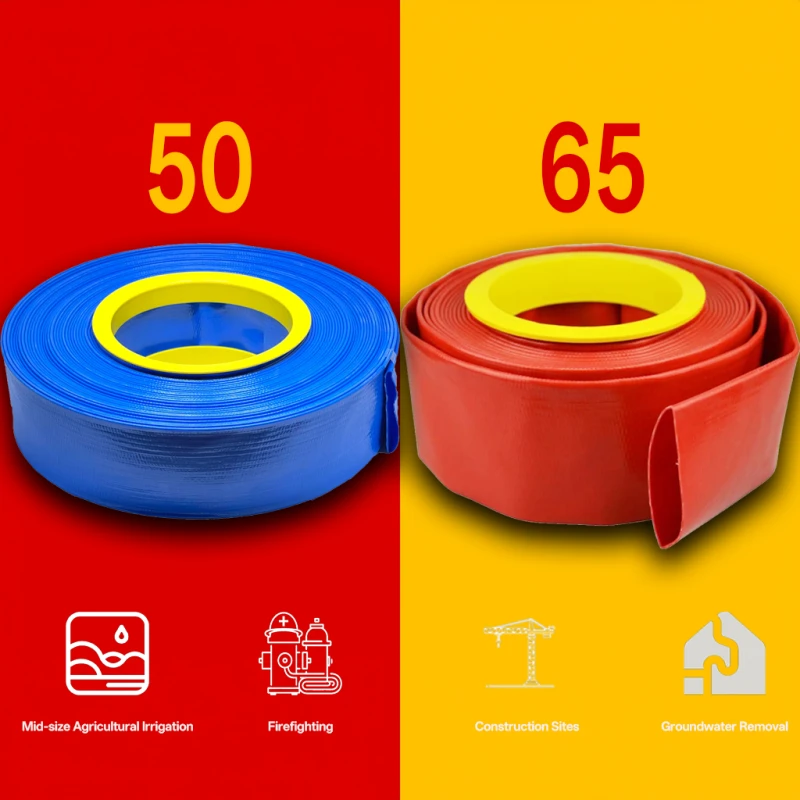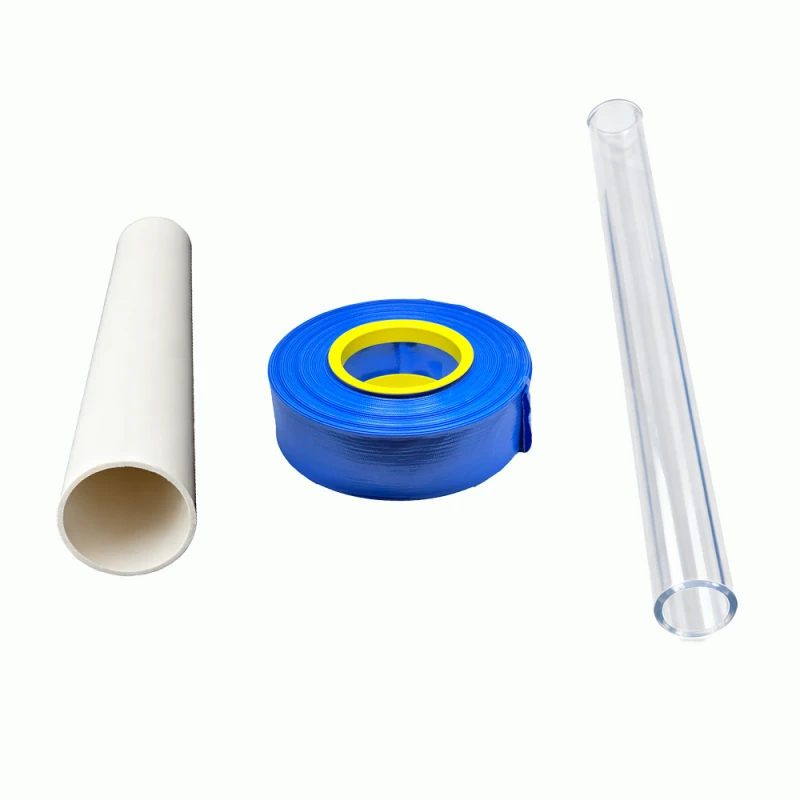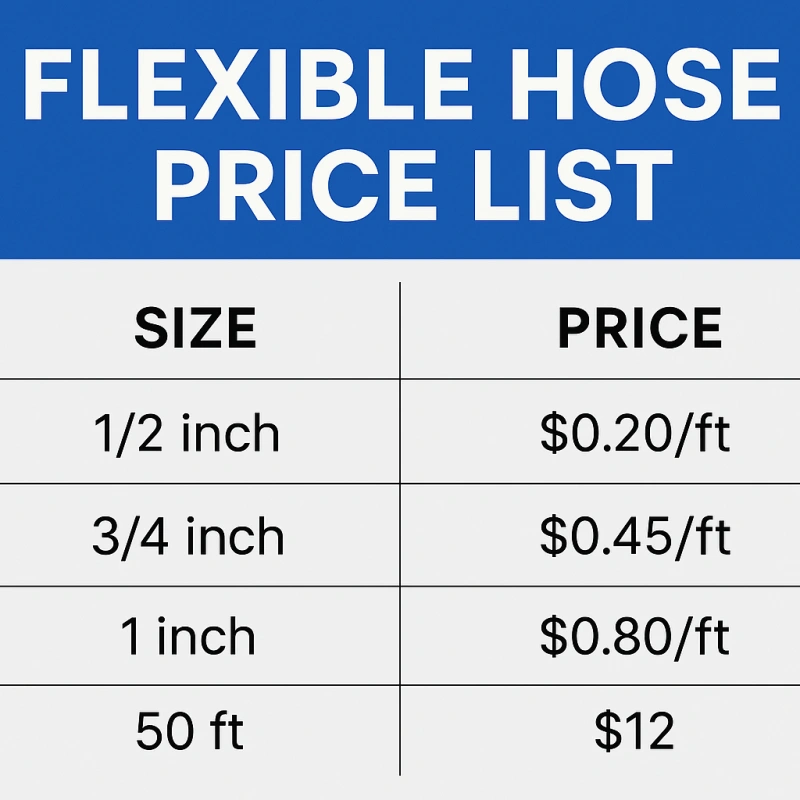50mm vs 65mm Layflat Hose: Which One Fits Your Needs
Choosing between a 50mm or 65mm layflat hose? This in-depth guide explores flow capacity, pressure ratings, handling, and cost. With real-world data and expert advice from QINGDAO RENATO PLASTIC CO., LTD, you'll discover which hose fits your project best—whether you're managing irrigation, water discharge, or industrial fluid systems.

If you're navigating the world of PVC layflat hoses, chances are you're weighing options between different diameters — especially the ever-popular 50mm and 65mm layflat hose sizes. Choosing the right one isn’t just about millimeters or pressure numbers; it’s about how those specs translate into performance on your job site, in your irrigation system, or across your industrial operation.
So, let’s dig deep. We'll compare these two in terms of flow rate, pressure handling, flexibility, cost-efficiency, and application suitability. We’ll also bring in some real-world insights, specific data, and manufacturer expertise — particularly from QINGDAO RENATO PLASTIC CO., LTD, a trusted name in hose manufacturing for over 15 years.
1. Understanding Layflat Hoses: A Brief Intro
Layflat hoses are flat when not in use, lightweight, and designed for quick deployment and storage. These hoses are most commonly used for irrigation, dewatering, and fluid delivery systems in agriculture, construction, mining, and firefighting.
But once you get into the field, you realize: size matters — especially when it comes to diameter. The inner diameter (ID) of the hose directly affects flow volume, friction loss, and pump compatibility. That’s where the 50mm vs. 65mm question gets real.
2. Quick Specification Snapshot
Let’s start with a straightforward comparison table for a high-quality PVC Layflat Hose:
| Specification | 50mm (2 inch) Hose | 65mm (2.5 inch) Hose |
|---|---|---|
| Inner Diameter | 50mm | 65mm |
| Typical Wall Thickness | 1.8 – 2.5mm | 2.0 – 3.0mm |
| Working Pressure | 4 – 8 bar | 4 – 6 bar |
| Burst Pressure | 12 – 24 bar | 10 – 20 bar |
| Max Flow Rate (approx.) | 160 – 220 L/min | 250 – 300 L/min |
| Hose Weight (per meter) | 0.25 – 0.35kg | 0.35 – 0.45kg |
| Common Applications | Small-scale irrigation, gardening | Larger irrigation, dewatering |
These values vary depending on material grade, hose thickness, and reinforcement level — but they paint a broad picture.
3. Flow Rate & Pressure: Does Bigger Always Mean Better?
Let’s talk water.
When comparing 50mm vs 65mm layflat hoses, your first consideration is often how much liquid you want to move, and how quickly. The 65mm hose, thanks to its larger diameter, obviously handles greater volumes per minute, making it perfect for applications where speed and volume trump everything else.
That said, there’s a tradeoff. Larger hoses like the 65mm variant tend to have lower pressure ratings. In high-pressure pumping environments, the 50mm hose may perform better over longer distances, particularly if you're working with booster pumps or facing terrain elevation changes.
“Flow rate is king in irrigation, but pressure retention becomes emperor in long-distance discharge.” — A saying often echoed in water management circles.
4. Use Cases: What Fits Where?
Not all farms are flat. Not every site has steady pressure. Let’s explore practical deployments.
A. When to Choose 50mm Layflat Hose
Small to mid-size agricultural irrigation systems
Urban drainage or water bypass systems
Firefighting or emergency services that prioritize mobility
Any application where distance or pressure is the priority
The 50mm hose is easier to store, lighter to handle, and better suited for portable pump setups.
B. When to Choose 65mm Layflat Hose
Commercial farms with high-volume crop irrigation
Construction sites requiring heavy water discharge
Flood management, especially in temporary channeling
Mining operations needing rapid groundwater removal
Here, the volume throughput of 65mm hoses makes them indispensable, especially when you’re emptying or filling fast.
5. Weight, Handling & Transportability
Let’s not underestimate the day-to-day physical labor of hose deployment. Here's a data table to give some clarity:
| Hose Size | 100m Roll Weight | Recommended Crew to Deploy | Ease of Manual Handling |
|---|---|---|---|
| 50mm | ~30–35 kg | 1–2 people | ☆☆☆ |
| 65mm | ~45–50 kg | 2–3 people | ☆☆ |
If you’re using these hoses daily, 50mm is far easier to coil, carry, and reload. On the other hand, if you’ve got machinery or more manpower, the added bulk of 65mm becomes a non-issue.
6. Cost Analysis: Initial + Long-Term
Let’s be honest — price matters.
| Hose Size | Avg. Price (Per Meter)* | Lifespan (With Regular Use) | Total Cost/Year (Est.) |
|---|---|---|---|
| 50mm | $1.50 – $2.30 | 2 – 4 years | ~$45/year |
| 65mm | $2.20 – $3.00 | 2 – 4 years | ~$60/year |
*Estimated based on high-quality hoses like those from QINGDAO RENATO PLASTIC CO., LTD, which use reinforced PVC and reliable pressure testing.
While 65mm hoses offer higher capacity, they come with higher upfront and replacement costs. For operations on a budget or seasonal use, 50mm may deliver better value.
7. What the Experts Say
At QINGDAO RENATO PLASTIC CO., LTD, with over 60 production lines and more than 15 years in PVC hose manufacturing, the team has seen all the possible usage scenarios.
“Both 50mm and 65mm hoses have their place. It’s not about which is better overall, but which is right for your job site,” says Mr. Zhang, a senior technician at RENATO.
He further adds, “We manufacture these hoses with varying pressure ratings and wall thicknesses, so the same 50mm hose can serve a totally different function depending on whether it's single-layer or reinforced.”
And that’s the key — customization and matching specs with environment.
8. Case Study: Irrigation in Southeast Asia
A recent RENATO client in Thailand operating a sugarcane plantation switched from traditional 65mm rubber hoses to 50mm high-pressure PVC layflat hoses. The decision was driven by:
Difficulty in handling large-diameter rubber hoses over hilly terrain
Water source pressure fluctuations
Manpower shortage for daily deployment
The result? They reported 30% reduction in operational time, 15% lower maintenance costs, and easier hose recovery after monsoon season flooding.
This type of use-case proves the nuanced benefits of downsizing — when it makes sense.
9. Conclusion: So, Which One Is Right for You?
Let’s wrap it up:
| Factor | 50mm Hose | 65mm Hose |
|---|---|---|
| Portability | ☆☆☆ Easier to carry and deploy | ☆☆ Needs 2–3 people or tools |
| Flow Rate | ☆ For small to mid flow | ☆☆☆ Excellent for large volume |
| Pressure Handling | ☆☆☆ Better for long distance | ☆ May require pressure regulation |
| Cost Efficiency | ☆☆☆ Lower purchase & repair cost | ☆ Higher flow but higher cost |
| Durability (RENATO) | ☆☆☆ With reinforcement | ☆☆☆ Equally durable with right spec |
At the end of the day, 50mm hoses are great for portable, high-pressure, small-scale operations, while 65mm hoses shine in large-area irrigation, dewatering, or flood control.
10. Why Choose QINGDAO RENATO PLASTIC CO., LTD?
Whether you're going for 50mm, 65mm, or anything in between, quality is non-negotiable. QINGDAO RENATO PLASTIC CO., LTD provides:
Over 15 years of production experience
A massive facility with 10 workshops and 60+ production lines
Tailored hose solutions, fittings, and assemblies
Fast lead times and 7x24 hours quick response service
Exports to over 60 countries with a solid reputation
Need help deciding or want a custom quote?
Contact us now and get expert guidance on your hose requirements. We believe customers are always first, and our team is here to serve you around the clock.

